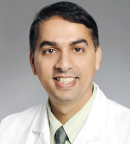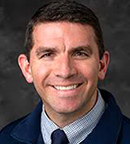
Mohammad K. Khan, MD, PhD

Clayton B. Hess, MD, MPH
Before the dawn of the modern antibiotic era and amid the chaos of World War II, future Professor of Radiology and Founding Dean of two American medical colleges, Dr. George T. Harrell,* penned what could now be argued was far too bold a statement. As the opening lines of his nonrandomized study of ionizing radiation for infectious pneumonia, he wrote: “The value of irradiation in … acute and chronic inflammations can no longer be doubted by anyone familiar with the repeated favorable response observed when this method is judiciously employed.” He could never have predicted his words would surface 75 years later as a catalyzing paradigm shift to future scientists seeking to help a world ravaged, not by war, but by pandemic.
It was March 1942. Stalin was fending off Nazi advances in Crimea and Leningrad. Still reeling from the Day of Infamy and surprise attacks at Pearl Harbor, Roosevelt had just announced the internment of Japanese Americans. MacArthur was evacuated from looming defeat in the Philippines, and London was recovering from months of German Blitz bombings. The genocide of millions of interned Jews and other victims shifted into full operation. Times were perilous.
Nonetheless, from the safety of Winston-Salem, North Carolina, Dr. Harrell, himself only in his first year as faculty, along with his coauthors, Drs. J.P. Rousseau and W.M. Johnson, persisted with their publication in Radiology to describe their 10-year Wake Forest experience treating bacterial pneumonia with low doses of ionizing radiation. Then somewhat mysterious and known as “roentgen therapy,” it predated any available antibiotics.
Effective but Unexplained
A single administration of radiation to pneumonic infiltrates, Dr. Harrell reported, resulted in a predictable 3- to 4-day period of clinical improvement, defervescence, and resolution of radiograph consolidations. Hospitalization time was halved. Mortality declined from 28% to 5.7%. The response was “striking.”
Dr. Harrell later went on to confirm a benefit of the use of x-rays in combination with the emerging sulfonamide antibiotics for refractory cases. “The action of x-rays in acute infections is not as yet satisfactorily explained,” he wrote. “Many theories have been advanced by various investigators and, sooner or later, conclusive proof of how and why small doses of x-ray[s] have a favorable influence on inflammatory processes will be established.” But Dr. Harrell’s vision of unraveling the mechanistic pathway of radiation’s anti-infectious effects was not to be. The treatment was soon forgotten, eclipsed into the shadows by Alexander Fleming’s discovery of penicillin in 1928 and its eventual mass production in the United States in the early 1940s.
Not 1 year after Dr. Harrell’s publication, pneumonia-prone Winston Churchill was saved from hemolytic streptococcus in Tunisia by sulfathiazole. The mass production of penicillin promoted by the efforts and research of Australian scientist Howard Florey and British-German researcher Ernst Chain at the end of WWII gave humanity the high ground over infection. In the decades since WWII, antibiotic use has been widespread and ever-more sophisticated. Indeed, in 1945, the Nobel Prize in Physiology or Medicine was awarded to Sir Alexander Fleming, Ernst Chain, and Sir Howard Florey for the discovery of penicillin and its curative effect in various infectious diseases.
There is little wonder why so few know of Dr. Harrell’s experiments and why even fewer modern clinicians would ever consider using ionizing radiation to treat infection.
“There is little wonder why so few know of Dr. Harrell’s experiments and why even fewer modern clinicians would ever consider using ionizing radiation to treat infection.”— Mohammad K. Khan, MD, PhD, and Clayton B. Hess, MD, MPH
Tweet this quote
Infectious Irony
Fast-forward 75 years through a generation of modern advances in technology and medicine into the 21st century paradigm of reusable rockets, the gig economy, and convenience automation. Still, in this modern future in which we live, a dichotomous infectious irony remains: while some infectious diseases stand completely or nearly eradicated by the antibiotic era, juxtaposed against these are others so unscathed by modern medicine, they seem to have been vaccinated against us.
Despite concerns of antibiotic resistance and antivaccination trends, it is these unscathed enemy infections, these seemingly invincible foes—mutagenic viruses—who terrorize humanity today. They have brought the world to its knees. Not unlike the days before Normandy, we need a counteroffensive. We have to take back the high ground.
It is March 2020. The coronavirus discovered in 2019 (COVID-19) and its threatening severe acute respiratory syndrome (SARS-COVID-19) have evaded our defenses. Over a million people are known to be infected, and the death toll approaches 100,000. Health-care workers–made-heroes face uncertain death on the front lines, while society retreats under the cover of social distancing. Researchers franticly search for treatments, for cures—for a weapon to fight back. Like wartime exercises, society’s leaders direct and delegate but see no weakness in their attacker. Exhuming the observations and the wartime experiments of Dr. Harrell, researchers et Emory University begin again to investigate the anti-infectious and anti-inflammatory properties of ionizing radiation.
Dual Pathway
Building on the work of Marie and Pierre Curie and Henri Becquerel in the early 20th century, we now know the mechanistic pathway whereby ionizing radiation selectively damages radiosensitive leukocytes and other inflammatory cells. Radiation’s high-energy photons enter the subatomic space and act in a dual pathway, wherein (1) they split the molecular bonds of (primarily) water to create free-radicalized hydroxide molecules, which then interact with cellular processes and nucleic acids, leading to single-strand DNA breaks; and (2) they split molecular bonds of DNA itself and lead to double-stranded breaks.
Specific pathways signal the recruitment of a host of repair enzymes, which quickly attempt to repair radiation’s shotgun-like smattering of genetic damage. This repair can be done slowly and thoroughly in cells with no need for frequent replication (like nerves and muscle) but leads to rapid death in cells highly programed for constant replication (like immune cells). Thus, as if in combat, ionizing radiation at precise doses can mow down a battlefield of armed lymphocytes while leaving the battleground itself alone, able to repair and mostly unscathed. The lifeless remnants of these legions of lymphocytes then emit an odor of sorts—cytokines and cellular particles that seep into the surrounding tissues and trigger the memory of our adaptive immunity, a kind of documentation of the slaughter that just transpired to ensure it doesn’t happen again.
To aid a body struggling to fight off a foreign pathogen that excessively ignites the immune system, radiation therapy can be delivered at doses to inhibit the inflammation but not hurt the host. Like an allied airstrike that levels the battlefield, radiation can silence a raging inflammatory conflict and allow the host to retake the high ground.
“To aid a body struggling to fight off a foreign pathogen that excessively ignites the immune system, radiation therapy can be delivered at doses to inhibit the inflammation but not hurt the host.”— Mohammad K. Khan, MD, PhD, and Clayton B. Hess, MD, MPH
Tweet this quote
Unexplored Potential
Low doses of radiation are currently used for many such inflammatory conditions, including Graves’ ophthalmopathy, heterotopic ossification, contractures, or arthritis, and also for lymphocyte-depleting purposes such as total-body irradiation, splenomegaly, Castleman’s disease of the interleukin-6 pathway, and to prevent transplant rejection, among others. Yet, to our knowledge, there are no reports to date that investigate the effect of low-dose radiation on the hyperimmunity caused by acute respiratory distress syndrome, or ARDS.
SARS-COVID-19 may result from a cascading hyperinflammatory macrophage activation event of the lungs similar to secondary hemophagocytic lymphohistiocytosis (HLH). In this process, when antigens from the captured coronavirus are presented by dendritic cells and macrophages for destruction, cytotoxic T cells cannot eliminate virus-infected cells from the body and instead continuously secrete inflammatory cytokines, which activate other immune cells to release still further cytokines. This results in a viscous cytokine storm that can lead to cellular infiltration and damage of vital organs. Analogously, the immunity battle becomes so intense that it leaves behind the scorched earth of irreparable organ damage.
Renewed Promise
The eventual mortality of COVID-19 patients on prolonged mechanical ventilation who host such cytokine storms in their lungs devastatingly ranges from 50% to 80%. Immunomodulating, low-dose radiation therapy has eliminated similar histiocytic processes (ie, Langerhans cell subtype) with response rates of over 90%. Although systemic anti-inflammatory agents that are given systemically have yielded unintended consequences, it is in-and-out stealth that may allow radiation therapy to selectively silence a cytokine storm while sparing its host. If so, effective but forgotten radiotherapy may become an important repurposed reinforcement, called up to battle to help alter the course of COVID-19’s HLH-mediated inflammatory storm.
“The discovery of past patients who were cured of pneumonia following ionizing radiation has catalyzed a strategic counterattack in the new World War we face against COVID-19.”— Mohammad K. Khan, MD, PhD, and Clayton B. Hess, MD, MPH
Tweet this quote
Because of this renewed promise and documented pre-antibiotic efficacy, Emory University has opened the first therapeutic trial of its kind delivering whole-lung radiation to hospitalized patients with COVID-19. The discovery of past patients who were cured of pneumonia following ionizing radiation has catalyzed a strategic counterattack in the new World War we face against COVID-19. So, it is on the shoulders of legacy scientists that we find a new foothold for our attempt to retake the high ground against the global pandemic—perhaps among the most important contributions of Dr. Harrell’s career and one he could have never predicted.
Drs. Khan and Hess work in the Department of Radiation Oncology, Emory University, Winship Cancer Institute, Atlanta.
DISCLOSURE: Dr. Khan has received honoraria from Cardinal Health and has received institutional research funding from Merck Sharp & Dohme. Dr. Hess reported no conflicts of interest.
* George T. Harrell was founding dean of the University of Florida (UF) College of Medicine in Gainesville, Florida, and the Pennsylvania State University (PSU) College of Medicine in Hershey. Dr. Hess, coincidentally, received his medical degree from PSU and was a medical literary award and research grant recipient from the same Department of Humanities founded by Dr. Harrell.

